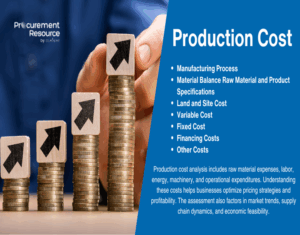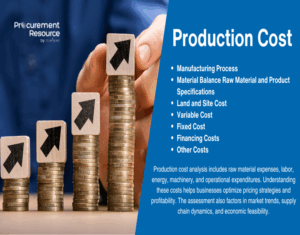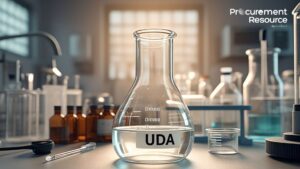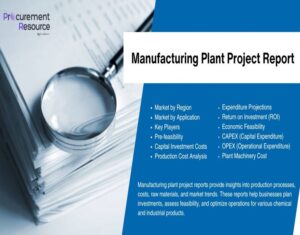
Ammonia is one of the most crucial chemicals used in various industrial applications, including fertilizers, explosives, refrigerants, and cleaning products. Given its wide range of uses, the production cost of ammonia is a significant concern for manufacturers, investors, and supply chain stakeholders. The cost of producing ammonia is influenced by several factors, including raw material costs, labor charges, utilities, industrial trends, and the efficiency of the production process.
In this article, we will explore an Extensive Ammonia Production Cost Report, breaking down the cost model, examining pre-feasibility factors, and discussing key insights into the industry’s trends, logistics, supply chain, and other vital cost drivers. Moreover, for those looking for a comprehensive understanding of ammonia production economics, we will also highlight how companies can optimize their production processes and reduce expenses.
Cost Model for Ammonia Production
The cost model for ammonia production is typically broken down into several key components that reflect the direct and indirect expenses involved in producing ammonia at scale. The production cost of ammonia primarily consists of:
Request For Sample: https://www.procurementresource.com/production-cost-report-store/ammonia/request-sample
- Raw Materials: The primary raw materials used in ammonia production are natural gas (or sometimes coal) and air, specifically nitrogen. The natural gas feedstock, used in the Haber-Bosch process, constitutes a significant portion of the production cost. The cost of natural gas can vary greatly depending on regional availability, pricing fluctuations in global markets, and geopolitical factors.
- Capital and Operational Expenses: The construction of an ammonia production facility requires substantial capital investment, particularly for large-scale plants. Operational costs also include energy consumption, as ammonia production is an energy-intensive process. Electricity and fuel costs make up a large part of operational expenses.
- Labor Charges: Labor costs are another essential component in the ammonia production process. Skilled workers are needed for plant operations, maintenance, and management. Labor costs can vary based on the location of the facility, as countries with higher wages will typically see higher labor charges.
- Maintenance Costs: Regular maintenance and repair of equipment and machinery in ammonia production plants are essential for ensuring efficient and continuous operation. Maintenance costs are incurred throughout the lifecycle of the plant and must be factored into the overall production cost.
- Environmental Compliance: As ammonia production can have a significant environmental impact due to emissions and chemical waste, companies must ensure they comply with environmental regulations. The cost of managing these aspects is an essential factor in the overall ammonia production cost model.
Pre-feasibility Analysis in Ammonia Production
Before embarking on large-scale ammonia production, a pre-feasibility analysis is critical to determine the potential financial viability and market readiness of the facility. This analysis typically includes an assessment of:
- Raw Material Availability: The proximity and availability of natural gas, water, and other essential raw materials influence the overall project cost.
- Technological Choice: The selection of production technology (e.g., Haber-Bosch process, smaller-scale alternatives) impacts both capital and operational expenses.
- Energy Efficiency: Evaluating energy consumption patterns and exploring potential efficiencies can significantly affect the cost model.
- Regulatory Environment: Understanding regional environmental policies and production regulations is essential for compliance and budget planning.
- Market Demand: A market analysis to determine ammonia demand, particularly in the fertilizer industry, helps in gauging long-term viability.
A Pre-feasibility study helps companies assess the project scope, potential risks, and financial returns before moving forward with large investments.
Industrial Trends and Market Drivers in Ammonia Production
Ammonia production is heavily influenced by global industrial trends and market dynamics. Some of the key trends shaping the ammonia production landscape today include:
- Renewable Energy Integration: As the world moves toward sustainable energy, renewable sources like wind and solar are increasingly being incorporated into ammonia production processes. This transition is expected to drive long-term cost savings, although initial capital costs for such setups may be high.
- Technology Advancements: The ammonia industry is witnessing significant technological innovations that focus on increasing efficiency and reducing emissions. The development of new catalysts, better energy management systems, and improved reactor designs is helping companies lower production costs.
- Environmental and Carbon Regulations: Stringent environmental policies, including carbon taxes and emission reduction targets, are pushing ammonia producers to adopt cleaner technologies and processes. These regulations are expected to increase operational costs initially but could yield long-term savings through energy efficiencies and lower penalties.
- Supply Chain Disruptions: The global supply chain has faced several disruptions in recent years due to factors such as the COVID-19 pandemic, geopolitical tensions, and rising fuel costs. For ammonia producers, these disruptions have created volatility in raw material costs and transportation expenses.
- Demand for Fertilizers: Ammonia is primarily used in the production of nitrogen-based fertilizers, which are critical for the global agricultural industry. As the global population continues to rise, so does the demand for food, which in turn drives the need for fertilizers. Thus, fluctuations in the demand for ammonia directly affect its market price and production costs.
Utilities and Energy Costs in Ammonia Production
Energy consumption is a major contributor to the production cost of ammonia. Ammonia plants require vast amounts of energy to operate, primarily in the form of electricity and natural gas. The energy required for:
- Compression: Natural gas needs to be compressed before it undergoes the Haber-Bosch process.
- Heating: High temperatures are essential for the ammonia synthesis process.
- Electricity: Ammonia plants also require electricity for various other functions, such as air separation and auxiliary systems.
The cost of energy can fluctuate based on geographic location and market conditions. For example, ammonia producers located in areas with cheap natural gas or renewable energy sources may see a reduction in their operational costs.
Logistics and Supply Chain in Ammonia Production
The logistics and supply chain of ammonia production are crucial in ensuring that raw materials are sourced efficiently and products are delivered on time. A well-organized supply chain can help reduce transportation costs and improve inventory management. Key logistics considerations include:
- Raw Material Sourcing: Sourcing natural gas and nitrogen at competitive prices is essential for managing production costs. Logistics operations must be optimized to ensure timely and cost-effective deliveries.
- Transportation: Ammonia is typically transported via pipelines, trucks, or rail. The choice of transportation method can significantly impact overall logistics costs.
- Storage: Efficient storage facilities are needed to store ammonia in both liquid and gas forms. This involves investing in tanks and safety measures to ensure the safe storage and handling of ammonia.
Optimizing the supply chain and logistics can significantly reduce overheads, ensuring cost-efficient ammonia production.
Request a Free Sample
For those seeking a deeper understanding of ammonia production costs, we offer an Extensive Ammonia Production Cost Report. This detailed report provides an in-depth analysis of all cost components involved in ammonia production, including raw material costs, utilities, labor charges, energy requirements, and logistics.
To request a free sample of this report: https://www.procurementresource.com/production-cost-report-store/ammonia/request-sample
The production cost of ammonia is driven by various factors, including raw materials, energy, labor, and technological advancements. Companies involved in ammonia production must keep track of industrial trends, environmental regulations, and market dynamics to stay competitive. Conducting a thorough Ammonia Production Cost analysis and understanding key drivers is crucial for identifying cost-saving opportunities and improving overall profitability.
For businesses looking to gain more insight into ammonia production costs, the Procurement Resource offers comprehensive reports that delve deep into cost models, market trends, and cost-optimization strategies. Requesting a sample of the Ammonia Production Cost Report can offer valuable insights into enhancing your ammonia production operations.
Contact Us:
Company Name: Procurement Resource
Contact Person: Endru Smith
Email: sales@procurementresource.com
Toll-Free Number: USA & Canada - Phone no: +1 307 363 1045 | UK - Phone no: +44 7537171117 | Asia-Pacific (APAC) - Phone no: +91 1203185500
Address: 30 North Gould Street, Sheridan, WY 82801, USA






